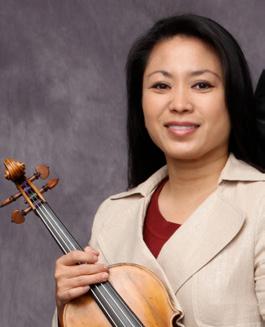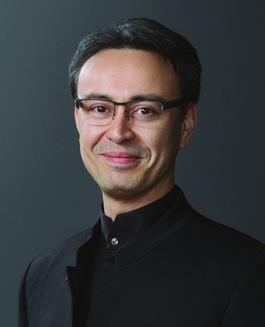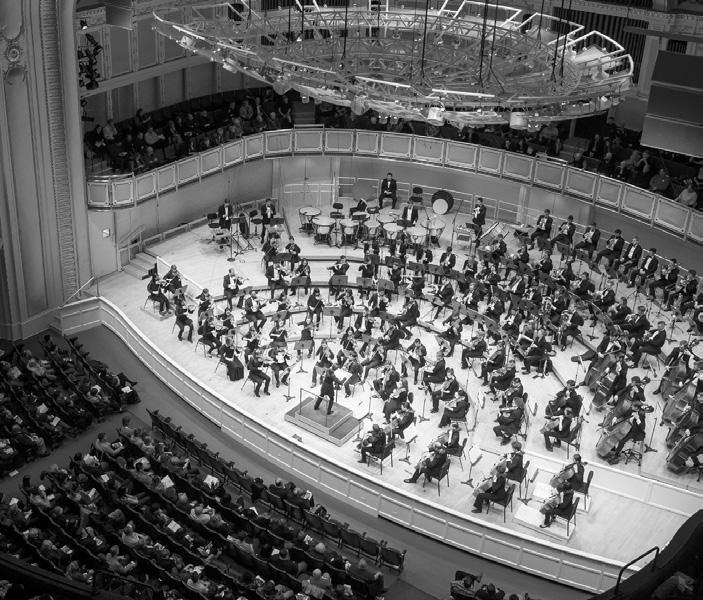ONE HUNDRED FIFTH
SEASON
CIVIC ORCHESTRA OF CHICAGO KEN-DAVID MASUR Principal Conductor
The Robert Kohl and Clark Pellett Principal Conductor Chair
Sunday, April 7, 2024, at 2:00
Kenwood Academy High School
Ken-David Masur Conductor
NEWBOLD Mythos
Jhonatan Roldan-Ramirez, conductor Students from the Kenwood Academy Music Department
MAN Glimpses of Muqam Chebiyat
II. Chebiyat Muqam—Third Dastan
Jhonatan Roldan-Ramirez, conductor Students from the Kenwood Academy Music Department
PROKOFIEV
Symphony No. 5 in B-flat Major, Op. 100
Andante
Allegro moderato
Adagio
Allegro giocoso
The 2023–24 Civic Orchestra season is generously sponsored by Lori Julian for the Julian Family Foundation, which also provides major funding for the Civic Fellowship program.
This project is supported in part by the National Endowment for the Arts.
The Civic Orchestra of Chicago acknowledges support from the Illinois Arts Council.
The 2023–24 Civic Orchestra season is generously sponsored by Lori Julian for the Julian Family Foundation, which also provides major funding for the Civic Fellowship program.
2
COMMENTS
SOON HEE NEWBOLD
Born November 11, 1974; Seoul, South Korea
Mythos
COMPOSED 2005
FIRST PERFORMANCE
2006, Ohio Music Education Association District 13 Honor Orchestra
INSTRUMENTATION string orchestra
APPROXIMATE PERFORMANCE TIME 3 minutes

Soon Hee Newbold is an internationally acclaimed composer and conductor known for incorporating differing cultural and ethnic styles in her writing, inspired by her experiences and travel. She started studying piano at age five and violin at seven and has performed as a concert artist in professional ensembles around the world. As a composer, Newbold’s works are performed by groups ranging in all levels from professional
symphonies to beginning elementary ensembles in venues such as Carnegie Hall, the Kennedy Center, Wolf Trap, Disney Hall, Lincoln Center, Midwest Band and Orchestra Clinic, and many more worldwide stages. In addition, Newbold is frequently sought after as a keynote speaker and guest clinician. She has conducted and worked with orchestras and bands throughout the United States and overseas in the Netherlands, Belgium, Australia, Indonesia, Singapore, and China. As a filmmaker and composer in Hollywood, she makes music that can also be heard in film and other recording projects.
Newbold’s Mythos is inspired by myths, legends, and fairy tales and is filled with unique harmonies and driving melodies. The different sections, performed without pause, include “Once Upon a Time,” “Fantasy,” and “Final Victory.” The work is dedicated to the Ohio Music Education Association District 13 Honor Orchestra and is intended to spark the imagination of young players and listeners.
—Alfred Music
CSO.ORG 3
above: Soon Hee Newbold
WU MAN
Born January 2, 1963; Hangzhou, Zhejiang, China
Glimpses of Muqam Chebiyat
COMPOSED 2015
FIRST PERFORMANCE
September 17, 2016; the Kronos Quartet; the Black Box Theater, Arts Center at NYU Abu Dhabi, UAE
INSTRUMENTATION string orchestra
APPROXIMATE PERFORMANCE TIME 4 minutes

Recognized as the world’s premier pipa virtuoso and leading ambassador of Chinese music, Grammy Award–nominated musician Wu Man has carved out a career as a soloist, educator, and composer, giving her lute-like instrument—which has a history of over 2,000 years in China—a new role in both traditional and contemporary music. Having been brought up in the Pudong School of pipa playing, one of the most prestigious classical styles of imperial China, Wu Man is now recognized as an outstanding exponent of the traditional repertoire as well as a leading interpreter of contemporary pipa music by today’s most prominent
composers. Wu Man’s efforts were recognized when she was named Musical America’s 2013 Instrumentalist of the Year, the first time this prestigious award has been bestowed on a player of a non-Western instrument.
Wu Man was born in Hangzhou, China, and studied at the Central Conservatory of Music in Beijing, where she became the first recipient of a master’s degree in pipa. She was accepted into the conservatory at thirteen, and her audition was covered by national newspapers. She was hailed as a child prodigy, becoming a nationally recognized role model for young pipa players. In 1985 she made her first visit to the United States as a member of the China Youth Arts Troupe. Wu Man moved to this country in 1990 and currently resides with her husband and son in California.
Wu Man on Glimpses of Muqam Chebiyat
Glimpses of Muqam Chebiyat is a two-movement suite that, taken with Two Chinese Paintings, resembles a set of portraits of traditional cultures from around China. In Chinese traditional music, instrumental pieces often have poetic titles to express their content and style. I decided to continue this tradition with above: Wu Man
4
COMMENTS
this collection. The inspiration for these suites came from styles of traditional music in China familiar to me, including Uyghur Maqam of Xinjiang province, a pipa scale from the ninth century, and the Silk-and-Bamboo music, or teahouse music, from my hometown of Hangzhou.
Glimpses of Muqam Chebiyat is adapted from the Uyghur Muqam Chebiyat. In 2010, thanks to the Aga Khan music initiative, I had the opportunity to learn these pieces directly from the Uyghur musicians Abdullah Majnun and Sanubar Tursun.
I feel quite grateful to be able to bring these old styles of traditional
music—Uyghur Muqam, Jiangnan Silkand-Bamboo music, and ancient pipa music—into the repertoire of Western string ensembles. The left-hand portamento, or sliding, technique called for here is quite distinct from the types of expression found in Western music. I hope that audiences will come to better understand the richness and diversity of music from China through these stories.
Glimpses of Muqam Chebiyat was commissioned as part of Kronos Fifty for the Future, made possible by a group of adventurous partners, including Carnegie Hall and many others.
—Courtesy of 50 for the Future: The Kronos Learning Repertoire
CSO.ORG 5 COMMENTS
SERGEI PROKOFIEV
Born April 23, 1891; Sontsovka, Ukraine
Died March 5, 1953; Nikolina Gora, near Moscow, Russia
Symphony No. 5 in B-flat
Major, Op. 100
COMPOSED
1944
FIRST PERFORMANCE
January 13, 1945; Moscow, Russia. The composer conducting
INSTRUMENTATION
two flutes and piccolo, two oboes and english horn, two clarinets, E-flat clarinet and bass clarinet, two bassoons and contrabassoon, four horns, three trumpets, three trombones, tuba, piano, harp, timpani, triangle, cymbals, tambourine, snare drum, woodblock, bass drum, tam-tam, strings
APPROXIMATE PERFORMANCE TIME
46 minutes

Sergei Prokofiev spent the summer of 1944 at a large country estate provided by the Union of Soviet Composers as a refuge from the war and as a kind of think tank. Prokofiev arrived early in the summer and found that his colleagues included Glière, Shostakovich, Kabalevsky, Khachaturian, and Miaskovsky—summer camp for the most distinguished Soviet composers of the time.
Although Ivanovo, as the retreat was called, often was referred to as a rest home, there was little leisure once Prokofiev moved in. He maintained a rigorous daily schedule—as he had all his life—and began to impose it on the others as well. “The regularity with which he worked amazed us all,” Khachaturian later recalled. Prokofiev ate breakfast, marched to his studio to compose, and scheduled his walks and tennis games by the clock. In the evening, he insisted the composers all get together to compare notes, literally. Prokofiev was delighted, and clearly not surprised, that he usually had the most to show for his day’s work.
It was a particularly productive summer for Prokofiev—he composed both his Eighth Piano Sonata and the Fifth Symphony before he returned to Moscow. The sonata is prime Prokofiev and often played, but the symphony is perhaps the best known and most regularly performed of all his works. It had been fifteen years since Prokofiev’s last symphony, and both that symphony and the one preceding it had been by-products of theater pieces: the Third Symphony is musically related to the opera The Flaming Angel, and the Fourth to the ballet The Prodigal Son Not since his Second Symphony, completed in 1925, had Prokofiev composed
6 COMMENTS
above: Sergei Prokofiev, in a portrait by Pyotr Konchalovsky (1876–1956), 1934
a purely abstract symphony or one that he began from scratch.
Although it was written at the height of the war, Prokofiev’s Fifth Symphony isn’t a wartime symphony in the traditional sense—not in the vivid and descriptive manner of Shostakovich’s Seventh, composed during the siege of Leningrad and written, in Carl Sandburg’s words, “with the heart’s blood”—or his Eighth, which coolly contemplates the horrors of war. (Those two scores date from 1941 and 1943, shortly before Prokofiev began this work.) Prokofiev’s Symphony no. 5 is intended to glorify the human spirit, “praising the free and happy man—his strength, his generosity, and the purity of his soul.” In its own way, this outlook makes it an even greater product of the war because it was designed to uplift and console the Soviet people. “I cannot say I chose this theme,” Prokofiev wrote. “It was born in me and had to express itself.” Nonetheless, such optimistic and victorious music cheered the Russian authorities; it might well have been made to order. In his 1946 autobiography, Prokofiev writes: “It is the duty of the composer, like the poet, the sculptor, or the painter, to serve the rest of humanity, to beautify human life, and to point the way to a radiant future. Such is the immutable code of art as I see it.” It also was the code of art Soviet composers were expected to embrace during the war, but Prokofiev couldn’t have written a work as powerful and convincing as his Fifth Symphony if he didn’t truly believe those words.
The Fifth Symphony would inevitably be known as a victory celebration. Just before the first performance, which Prokofiev conducted, word reached Moscow that the Russian army had scored a decisive victory on the Vistula River. As Prokofiev raised his baton, the sound of cannon was heard from the distance. Buoyed by both the news and the triumphant tone of the music, the premiere was a great success. It was the last time Prokofiev conducted in public. Three weeks later, he had a mild heart attack, fell down the stairs in his apartment, and suffered a slight concussion. Although he recovered his spirits—and eventually his strength and creative powers as well—Prokofiev continued to feel the effects of the accident for the remaining eight years of his life.
The first movement of the Fifth Symphony is intense and dramatic but neither aggressive nor violent, like much of the music written at the time. It is moderately paced (Prokofiev writes andante) and broadly lyrical throughout. The scherzo, in contrast, is quick and insistent, touched by a sense of humor that sometimes reveals a sharp, cutting edge. The third movement is lyrical and brooding, like much of Prokofiev’s finest slow music. After a brief and sober introduction, the finale points decisively toward a radiant future.
—Phillip Huscher
Phillip Huscher is the program annotator for the Chicago Symphony Orchestra.
CSO.ORG 7 COMMENTS
PROFILES
Ken-David Masur Conductor

Ken-David Masur celebrates his fifth season as music director of the Milwaukee Symphony Orchestra and principal conductor of the Chicago Symphony’s Civic Orchestra. He has conducted distinguished orchestras around the world, including the Chicago Symphony, Los Angeles Philharmonic, San Francisco Symphony, Orchestre National de France, Yomiuri Nippon Symphony, National Philharmonic of Russia, and other orchestras throughout the United States, France, Germany, Korea, Japan, and Scandinavia.
Masur’s tenure in Milwaukee has been marked by innovative thematic programming, including a festival celebrating the music of the 1930s, when the Bradley Symphony Center was built, and the Water Festival, which highlighted local community partners whose work centers on water conservation and education. He also instituted a multi-season artist-in-residence program and led highly acclaimed performances of major choral works, including a semistaged production of Peer Gynt.
This season, he begins a residency with bass-baritone Dashon Burton and leads the MSO in an inaugural citywide Bach festival, celebrating the diverse and universal appeal of J.S. Bach’s music in an ever-changing world.
Last season, Masur made his New York Philharmonic debut in a gala
program featuring John Williams and Steven Spielberg. He also debuted at the Pacific Music Festival in Sapporo, Japan, and at Classical Tahoe in three programs broadcast on PBS. He led the Boston Symphony Orchestra, Yo-Yo Ma, Itzhak Perlman, Branford Marsalis, and James Taylor at Tanglewood in a ninetieth birthday concert for John Williams. Summer 2023 marked Masur’s debuts with the Grant Park Festival and the National Repertory Orchestra; later this season, he returns to the Baltimore Symphony and the Kristiansand Symphony.
For eight years, Masur served as principal guest conductor of the Munich Symphony. He was also associate conductor of the San Diego Symphony and resident conductor of the San Antonio Symphony.
Music education and working with the next generation of young artists are of major importance to Masur. In addition to his work with the Civic Orchestra of Chicago, he has conducted Tokyo’s Bunka Kaikan Chamber Orchestra and Tanglewood Music Center Orchestra and led master classes at the University of WisconsinMilwaukee’s Peck School of the Arts, New England Conservatory, Manhattan School of Music, Boston University, Boston Conservatory, and the Juilliard School, where he leads the Juilliard Orchestra this fall.
Masur and his family are proud to call Milwaukee their home and enjoy exploring all the riches of the Third Coast.
PHOTO BY ADAM DETOUR
8
Civic Orchestra of Chicago
Founded in 1919 by Frederick Stock, second music director of the Chicago Symphony Orchestra (CSO), the Civic Orchestra of Chicago prepares emerging professional musicians for lives in music. Civic members participate in rigorous orchestral training, September through June each season, with the Robert Kohl and Clark Pellett Principal Conductor Ken-David Masur, musicians of the CSO, and some of today’s most luminary conductors, including Riccardo Muti, the CSO’s music director emeritus for life.
The importance of the Civic Orchestra’s role in Greater Chicago is underscored by its commitment to present concerts of the highest quality at no charge to the public. In addition to the critically acclaimed live concerts at Symphony Center, Civic Orchestra performances can be heard locally on WFMT (98.7 FM).
Civic musicians also expand their creative, professional, and artistic boundaries and reach diverse audiences through educational performances at Chicago Public Schools and a series of chamber concerts at various locations throughout the city, including Chicago Park District fieldhouses and the National Museum of Mexican Art.
To further expand its musician training, the Civic Orchestra launched the Civic Fellowship program in the
2013–14 season. Each year, ten to fifteen Civic members are designated as Civic Fellows and participate in intensive leadership training that is designed to build and diversify their creative and professional skills.
From 2010 to 2019, Yo-Yo Ma was a leading mentor to Civic musicians and staff in his role as CSO Judson and Joyce Green Creative Consultant, and the programs and initiatives he established are integral to the Civic Orchestra curriculum today. Civic Orchestra musicians develop as exceptional orchestral players and engaged artists, cultivating their ability to succeed in the rapidly evolving world of music in the twenty-first century.
The Civic Orchestra’s long history of presenting full orchestra performances free to the public includes annual concerts at the South Shore Cultural Center (in partnership with the South Shore Advisory Council) as well as numerous Chicago Public Schools. The Civic Orchestra is a signature program of the Negaunee Music Institute at the Chicago Symphony Orchestra, which offers a wide range of education and community programs that engage more than 200,000 people of diverse ages, incomes, and backgrounds each year in Chicago and around the world.
For more on the Civic Orchestra of Chicago and its Principal Conductor Ken-David Masur, please visit cso.org/civic.
CSO.ORG 9 PROFILES
PROFILES
Civic
Orchestra of Chicago
Ken-David Masur Principal Conductor
The Robert Kohl and Clark Pellett Principal Conductor Chair
VIOLINS
Ran (Ryan) Huo
Mona Munire Mierxiati
Jonah Kartman
Sheena Lan
Kimberly Bill
Elise Maas
Alec Tonno
Hojung Christina Lee
Darren Carter
Isabelle Chin
Nelson Mendoza
Lina Yamin*
Annie Pham
Danira Rodríguez-Purcell
Janani Sivakumar
Marian Antonette Mayuga*
Heewoo Seo
Hobart Shi
Matthew Weinberg
Matthew Musachio*
Valentina Guillen Menesello
Sean Hsi
J. Andrés Robuschi
Justine Teo
Megan Pollon
Alba Layana Izurieta
VIOLAS
Sanford Whatley
Michael Ayala
Sava Velkoff
Carlos Lozano
Derrick Ware
Justin Pou
Junghyun Ahn
Megan Yeung
Elena Galentas
Santiago Del Castillo
Lucie Boyd
Rebecca Miller
CELLOS
David Caplan
Miles Link
Lidanys Graterol
Buianto Lkhasaranov
J Holzen*
Francisco Lopez Malespin*
Lindsey Sharpe
Niraj Patil
Cameron Slaugh
Chad Polk
BASSES
Ben Foerster*
Hannah Novak
Broner McCoy
James O’Toole
Tiffany Kung
Leo Finan
Daniel W. Meyer
Walker Dean
FLUTES
Aalia Hanif*
Jungah Yoon
Katarina Ignatovich
PICCOLOS
Aalia Hanif*
Jungah Yoon
OBOES
James Kim
Natalie Johnson
ENGLISH HORN
Hannah Fusco
CLARINETS
Elizabeth Kapitaniuk
Amy Hur*
E-FLAT CLARINET
Tyler Baillie
BASS CLARINET
Nathan Vilhena Kock
* Civic Orchestra Fellow
BASSOONS
Ian Arthur Schneiderman
Seo Young (Michelle) Min
CONTRABASSOON
William George
HORNS
Asunción Martínez
Ryan Williamson
Loren Ho
TRUMPETS
Sean-David Whitworth
Kai-Chun Chang
Abner Wong
TROMBONES
Hugo Saavedra*
Jihong Son
BASS TROMBONE
Alexander Mullins
TUBA
Ben Poirot
TIMPANI
Tomas Leivestad
PERCUSSION
Charley Gillette
Alex Chao
Sehee Park
Dominik McDonald
Karel Zambrano
HARP
Janna Young
KEYBOARD
Wenlin Cheng
LIBRARIAN
Benjimen Neal
10
Students from the Kenwood Academy Music Department
VIOLINS
Justin Coleman
Jahel Crowder
Frida-Sofia Gallick
Lamont St Clair Haygood
Owen Johnson
Lena Owens
Brooke Vercher
Makaila Bonsu
Christian Copeland
Lahna Davis
T’Anna Lomack
Andre Madison
Lydia Popova
Gayle Sancho
Maya Wells
Anthony Owens
Christopher Richards
Warren Sims
Layla Wells
Patricia Washington
VIOLAS
Lauren Butler
Davon Davis
Laila Johnson
Jehreal Webster
Adele Jennings
Gabrielle Barbosa
Arion Sharegh
Elliot Swanson
BASSES
C’Maria Thurman
Khamari Hall
Jeremiah Davis
Brianne Gee-Simpson
David Nyam



A gift to the Civic Orchestra of Chicago supports the rigorous training that members receive throughout the season, which includes coaching from musicians of the Chicago Symphony Orchestra and world-class conductors.
Your gift today ensures that the Chicago Symphony Orchestra Association will continue to enrich, inspire and transform lives through music.
A gift to the Civic Orchestra of Chicago supports the rigorous training that members receive throughout the season, which includes coaching from musicians of the Chicago Symphony Orchestra and world-class conductors.
Your gift today ensures that the Chicago Symphony Orchestra Association will continue to enrich, inspire and transform lives through music.

CSO.ORG 11 PROFILES
CSO.ORG/GIVETOCIVIC 312-294-3100
3100 SCAN TO GIVE
CSO.ORG/GIVETOCIVIC 312 -294 -
CIVIC ORCHESTRA OF CHICAGO SCHOLARSHIPS
Members of the Civic Orchestra receive an annual stipend to help offset some of their living expenses during their training in Civic. The following donors have generously underwritten a Civic musician(s) for the 2023–24 season.
Eleven Civic members participate in the Civic Fellowship program, a rigorous artistic and professional development curriculum that supplements their membership in the full orchestra. Major funding for this program is generously provided by Lori Julian for the Julian Family Foundation
Nancy A. Abshire
Amanda Kellman, viola
Dr. & Mrs. Bernard H. Adelson Fund
Megan Yeung, viola
Sue and Jim Colletti
Nina Laube,* bassoon
Lawrence Corry
Jonah Kartman, violin
Robert and Joanne Crown Income Charitable Fund
Charley Gillette, percussion
James Kim, oboe
Buianto Lkhasaranov, cello
Daniel W. Meyer, bass
Subin Shin, violin Abner Wong, trumpet
Mr. † & Mrs. David A. Donovan
Jacob Medina, horn
Mr. & Mrs. Paul C. Gignilliat
Janani Sivakumar, violin
Mr. & Mrs. Joseph B. Glossberg
Hannah Novak, bass
Richard and Alice Godfrey
Matthew Weinberg, violin
Jennifer Amler Goldstein
Fund, in memory of Thomas M. Goldstein
Alex Chao, percussion
Chet Gougis and Shelley Ochab
Tomas Leivestad, timpani
Mary Winton Green
Victor Stahoviak, bass
Jane Redmond Haliday Chair
Mona Munire Mierxiati, violin
Lori Julian for the Julian Family Foundation
Nelson Mendoza, violin
Lina Yamin, violin
Lester B. Knight Charitable Trust
Valentina Guillen Menesello, violin
Elizabeth Kapitaniuk, clarinet
Elise Maas, violin
Ryan Williamson, horn
Brandon Xu, cello
League of the Chicago Symphony Orchestra Association
Lindsey Sharpe, cello
Leslie Fund Inc.
Francisco Lopez Malespin,* cello
Phil Lumpkin
Matthew Musachio,* violin
Glenn Madeja and Janet Steidl Abigail Monroe, cello
The Maval Foundation
Mark Morris, horn Felix Regalado, trombone
Judy and Scott McCue and the Leslie Fund Inc.
Aalia Hanif,* flute
† Deceased * Civic Orchestra Fellow + Partial Sponsor
Gifts listed as of February 2024
Dr. Leo and Catherine
Miserendino
Sean-David Whitworth, trumpet
Ms. Susan Norvich
Nick Collins,* tuba
Ben Poirot, tuba
Margo and Mike Oberman
Ben Foerster,* bass
Sandra and Earl J. Rusnak, Jr. †
Quincy Erickson, trumpet
Barbara and Barre Seid Foundation
Alexander Mullins, bass trombone
Hugo Saavedra,* trombone
The George L. Shields Foundation, Inc.
Hsuan Chen, violin
Carlos Lozano, viola
Cameron Slaugh, cello
David W. and Lucille G. Stotter Chair
Ran (Ryan) Huo, violin
Ruth Miner Swislow Charitable Fund
Kimberly Bill, violin
Lois and James Vrhel
Endowment Fund
Broner McCoy, bass
Theodore and Elisabeth Wachs
Hae Sol (Amy) Hur,+ clarinet
Dr. Marylou Witz
Marian Antonette Mayuga, violin
Anonymous
Jesús Linárez, violin
Anonymous
Gabriela Lara, violin
Anonymous
Hojung Christina Lee, violin
Anonymous
J Holzen,* cello
For complete donor listings, please visit the Richard and Helen Thomas Donor Gallery at cso.org/donorgallery.










